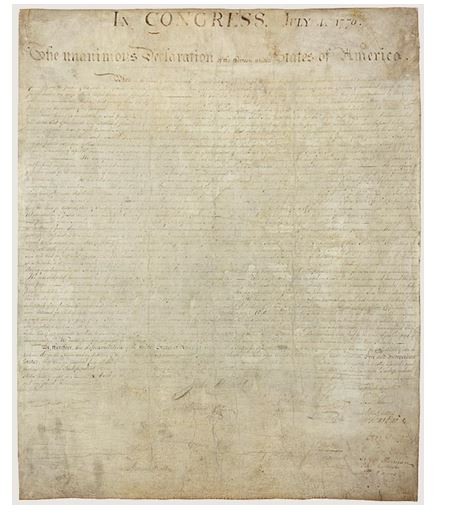Introduction
The Declaration of Independence was the first and, perhaps, the greatest document that laid the foundation for not only the country but also its people’s philosophy. Words “Life, Liberty, and Pursuit of Happiness” form the basis of the American dream (“The Declaration of Independence: A transcription,” 2017). According to Sayre (2013), seeing the story behind the event helps memorize and understand it better. For example, to apprehend the beauty and importance of the painting Liberty Leading the People it is vital to know the context of its creation (Sayre, 2013). Therefore, to assess the full significance and meaning of the Declaration it is necessary to delve into its historical background and text.
The Background for Adoption of the Declaration of Independence
The financial problems of the British Empire made it increase the taxes collected from colonies. The Stamp Act and Townshend Acts produced a series of burdening obligations, which marked the growth of discontent towards Britain. Many colonists believed that the Empire did not have the right to impose new taxes, as the British Parliament did not present their opinion at all.
Growing dissatisfaction with the new charges led to the famous Boston Tea Party when the protesters against the Empire threw into the ocean an entire load of tea shipped by the East India Company. The consequences followed in the form of a blockage of Boston port, revocation of power from Massachusetts, virtual immunity of British executives to the colonial law, and accommodation of Imperial soldiers in the houses of Americans. These measures provoked the reaction quite the opposite of what the British government hoped to achieve.
First military conflicts began in April 1775. King George rejected the second petition issued by the Continental Congress that aimed to prevent further violence and re-establish a good relationship. A full-scale war began. American people ceased to believe that a reunion on good terms with Britain was possible. Even though many colonists approved the separation from the British Empire, the elected Congressmen had no right to vote for it because they followed the instructions given to them upon election. On May 15, John Adams made a preamble that gave the reasoning behind the upcoming declaration of independence that raised some protests. However, the state of Virginia gave its delegation an instruction to propose an independence vote. After that, the other 12 states started to give similar instructions to their delegates. The final text of the declaration drafted by Thomas Jefferson was voted for and ratified on July 4.
Contents of the Declaration of Independence

The declaration is believed to be consisting of an introductory part, a preamble, charges against King George, a message to the British people, and a conclusion. The first part explains that people have a right to bring out the question of independence and voice it. The second part proclaims the right of common people to overthrow the government that violates their natural rights. The third part describes the 27 actions of King George III that oppressed the American people, which include unconditioned taxes, injustices of the imperial court, trade violation, and many others. The message to the British people concludes that although they did not want to sever relationships, it was still necessary as the American claims were left unanswered. In the last part, the document appeals to the higher power with this declaration proclaiming the separation from Britain and obtainment of freedom and all the qualities of a free state.
Conclusion
Overall, the Declaration of Independence united the American people under the common cause in the time of war and gave them the right and motivation to fight. Freedom being the keynote of the document became the central part of the American mindset that continues to influence life in the United States. One of the goals of today’s president, Donald Trump is reducing the share of a foreign workforce on the American labor market freeing job opportunities for the citizen of the country (“Bringing back jobs and growth,” 2017).
References
Bringing back jobs and growth (2017). Web.
The Declaration of Independence (2017). Web.
The Declaration of Independence: A transcription (2017). Web.
Sayre, H. M. (2013). Discovering the humanities (2nd ed.). Upper Saddle River, New Jersey: Prentice Hall.